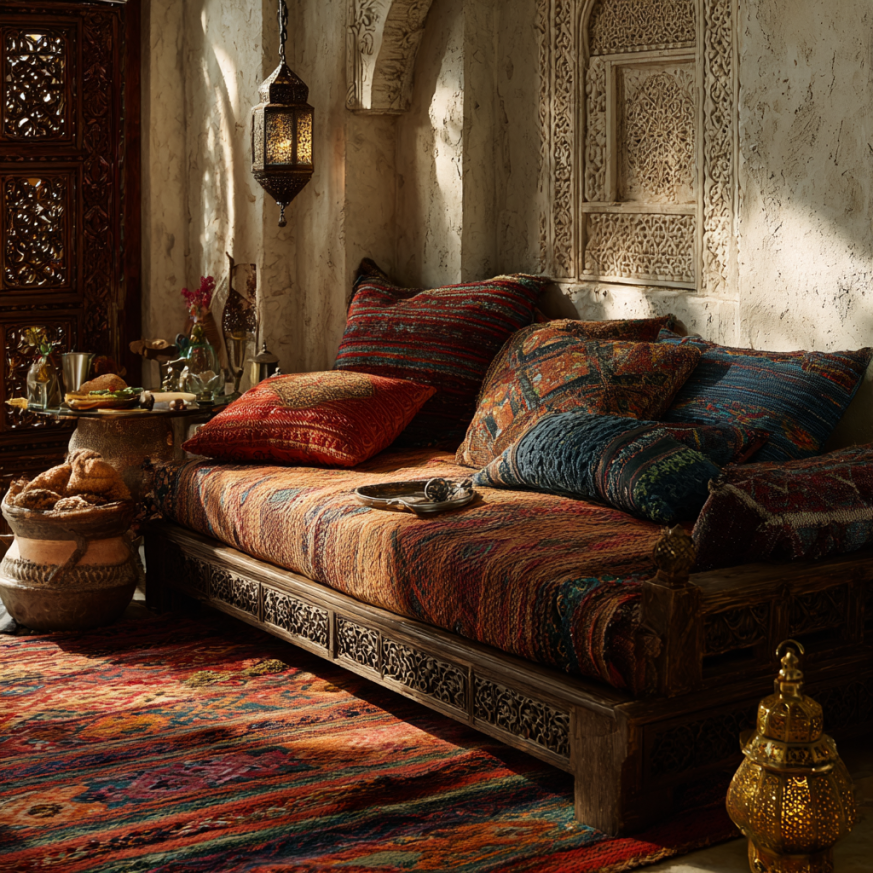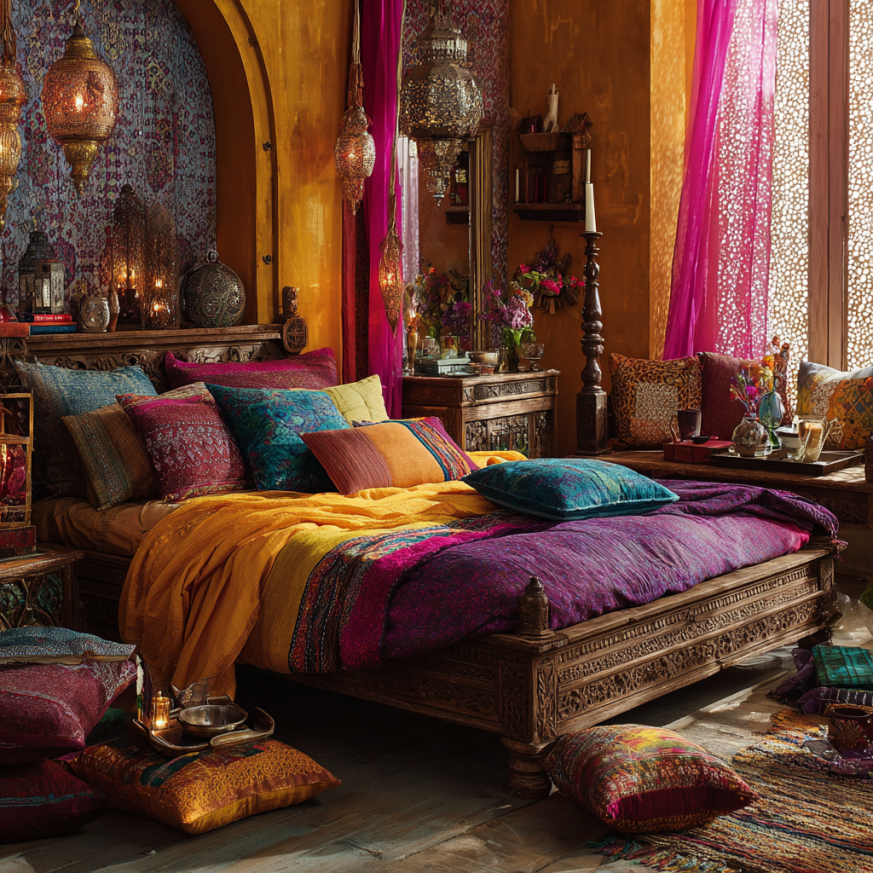
Bed Designs from Around the World
Looking to transform your bedroom? Explore a variety of bed designs from around the world that can inspire your space, whether you’re drawn to Moroccan patterns, Spanish warmth, Japanese minimalism, or Indian vibrancy. Each region brings its own flavor of comfort and artistry, and knowing these global styles can help you curate a bedroom that’s not just stylish but deeply personal and functional. For a foundational overview, see an overview of different types of beds.
Key Takeaways
- Moroccan bed designs feature geometric patterns, warm textures, and vibrant colors that create a cozy and exotic ambiance.
- Spanish bed decor embraces rustic elements, Mediterranean hues, and handmade touches like wrought iron and terracotta.
- Japanese and Japandi designs focus on serene simplicity, natural materials, and low‑profile beds for mindful living.
- Indian bedrooms are bursting with color, texture, and handcrafted textiles, offering both visual richness and comfort.
- European trends prioritize personal comfort and innovation, from Scandinavian duvets to Germany’s dual‑bed layouts. For Nordic specifics, explore Scandinavian bed design charm.
- North and South American styles span luxury and tradition—from expansive California beds to tranquil South American hammocks.
- Sub‑Saharan African bedding blends beauty with utility, showcasing netted beds and starlit sleep experiences.
- Traditional Asian designs highlight multifunctional beds like the kang stove‑bed and futons that adapt to minimalist lifestyles.
- Astronauts adapt to zero gravity with sleeping bags and sensory aids for comfort in space.
- Thoughtful choices in bed frames, lighting, fabrics, and furniture layout enhance the harmony and functionality of your space.
For more bedding inspiration, check out cozy bedding ideas from The Spruce and the best eclectic bedding picks from Architectural Digest.
Moroccan Bed Design
Transport your bedroom to the vibrant streets of Morocco with the timeless elegance of Moroccan bed designs. These spaces are more than just functional—they’re experiential. Inspired by centuries of art, architecture, and desert living, Moroccan‑style bedrooms often feature low‑profile beds framed by arched headboards or ornately carved wood. Patterns like zellige tiles and arabesque motifs echo in wall décor, textiles, and floor cushions.

To bring this design into your own space, consider layering patterned encaustic tiles beneath your bed frame or anchoring the room with a vivid Moroccan rug. Add oversized floor pillows with fringe or pom-poms, hang pierced metal lanterns that cast dramatic shadows, and incorporate mosaic side tables for a truly immersive look. Opt for deep, earthy hues like terracotta, indigo, and saffron—colors that reflect Moroccan sunsets and spice markets.
Don’t be afraid to mix textures: handwoven wool blankets, silky throws, leather poufs, and embroidered cushions all add layers of interest and comfort. If you’re on a budget, even a few well‑chosen accessories like a vintage kilim pillow or a brass mirror can introduce Moroccan flair.
Summary: Moroccan bed design is all about bold textures, vibrant patterns, and cozy layers that transform your bedroom into an exotic retreat filled with soul and style.
Spanish Bed Decor
Create a Mediterranean retreat with Spanish bed decor, where rustic elements and warm Mediterranean colors come together to create a peaceful and inviting atmosphere. Spanish interiors are known for blending Old World charm with down‑to‑earth simplicity, drawing inspiration from sun‑soaked landscapes and traditional haciendas.

To achieve this look, start with a solid wood bed frame—ideally dark‑stained or distressed. Complement it with handwoven textiles, embroidered bedspreads, and wrought iron accents. Walls painted in creamy whites or soft terra tones can serve as the perfect backdrop, while pops of olive green, burnt orange, or cobalt blue add life and energy to the room.
Spanish décor values authenticity and craftsmanship. Look for handmade ceramic lamps, vintage trunks at the foot of the bed, and artful tiling around windows or headboards. A woven wool throw draped over a rattan bench, or clay pots with rosemary or lavender, deepen the rustic yet romantic vibe.
Layer textures and add regional flair—like a Flamenco‑inspired tapestry or a carved headboard with Moorish influences. If space allows, a cozy reading nook with an arched window and gauzy curtains makes a wonderful finishing touch.
Summary: Spanish bed decor celebrates rustic warmth, rich textures, and timeless details. It’s ideal for those who crave a bedroom that feels grounded, soulful, and sun‑kissed.
Japanese and Japandi Bed Design
Embrace the tranquility and simplicity of Japanese design or the harmonious blend of Japanese and Scandinavian influences with Japandi bed design. This minimalist approach offers a calming sanctuary by emphasizing clean lines, natural textures, and intentional living.

In a Japanese‑inspired bedroom, low‑profile beds or futons rest on tatami mats. Wood slats, sliding shoji screens, and a palette of soft neutrals create a peaceful visual flow. Japandi adds Nordic warmth—cozy knit throws, pale wood furniture, and functional elegance. Bring the outdoors in with a bonsai tree or a nature‑inspired print. Bedrooms built around balance and reflection offer a sanctuary that’s both restful and mindful.
Summary: Japanese and Japandi styles invite you to slow down, simplify, and sleep in serenity—perfect for anyone craving peace, order, and understated elegance in their bedroom.
Indian Style Bedroom
Bring the vibrant energy of India into your bedroom with intricate patterns, colorful fabrics, and the traditional floor seating found in Indian‑style bedrooms. Rooted in centuries of cultural heritage and artisanal craftsmanship, Indian design celebrates a rich blend of colors, textures, and symbolism.

Start with a carved wood bed, layer in jewel‑toned linens, and accent with mirrored or embroidered throw pillows. Brass lanterns, block‑printed curtains, and a mandala wall hanging complete the look. Mix in floor poufs with rich embroidery, and bring in a carved wooden trunk for storage that doubles as décor.
Summary: Indian bedroom design is a celebration of color, craftsmanship, and cultural richness—ideal for those who seek an expressive and soulful sleeping space.
European Bed Trends
Discover unique trends from Europe, where personalized comfort and creativity take center stage. In Scandinavian countries, cozy textures meet minimalism, with individual duvets as a clever solution for partner sleepers (learn more about Nordic bed designs). In Germany, beds often feature two single mattresses—maximizing comfort while preserving aesthetics and intimacy.

Norway’s ice beds are perhaps the most adventurous—perfect for chilly sleepers or anyone seeking a unique sleep experience. Italian canopy beds and French Louis‑style headboards highlight elegance and romance in southern and western Europe. For historical context around European sleep culture, see medieval bedding traditions and the debated Renaissance bedding ceremonies.
Summary: European bed trends reflect a strong preference for personal comfort, creative flair, and thoughtful design—balancing aesthetics with customized rest solutions.
North and South American Bed Styles
From California’s luxury king beds to hammock living in South America, American bed styles are diverse. North American bedrooms typically emphasize comfort, plush bedding, and spacious layouts. South American sleeping setups, like indoor hammocks, offer minimalist and breathable alternatives ideal for warmer climates.

Examples of North American luxury include oversized mattress setups with adaptive firmness options and heated blankets—especially popular in colder regions. In contrast, lounging in hammocks under filtered light is common in homes across Brazil, Colombia, and Argentina, adding a relaxed rhythmic vibe.
Summary: Whether you prefer sprawling mattress space or an airy swing, the Americas offer options to match every sleeper’s lifestyle and climate needs.
Bedding in Sub-Saharan Africa
In Sub‑Saharan Africa, bedding blends form and function. Mosquito nets are common—both practical and decorative. Star beds allow for outdoor sleeping experiences under the sky, connecting you to nature in luxury safari style.

Whether in rural lodges or urban homes, beautiful woven nets with scalloped drapes create an elegant bedroom canopy. Outdoor platforms with crisp bedding—often raised for airflow—offer starlit sleeping without sacrificing comfort.
Summary: Sub‑Saharan African bedding celebrates nature, comfort, and cultural practicality, making every night’s rest a memorable one.
Asian Bed Designs
Asia offers diverse bed designs: Indian charpais, Chinese kang beds, and Japanese futons. These options focus on adaptability, natural materials, and space efficiency. Each reflects local culture and climate, encouraging a connection between environment and rest.

Charpais are woven rope or cane beds in India—lightweight, breathable, and perfect for hot weather. Kang beds include built-in stoves in northern China to stay warm in winter (dive deeper into traditional Chinese bed designs). Futons folded during the day and placed on tatami flooring enable multipurpose living spaces in Japan.
Summary: Asian bed traditions offer smart, minimalist alternatives that are both sustainable and aesthetically grounded in centuries‑old practices.
Conclusion
From luxurious European designs to functional Asian styles, bed designs from around the world offer more than aesthetic variety—they help shape how we rest, dream, and live. Each cultural style reflects its own story, inviting us to rethink our spaces not just as places to sleep, but as environments of comfort, identity, and inspiration.
To dive deeper into sleep wellness and bedroom styling, explore trusted resources like EachNight’s sleep guides or learn how to layer bedding for a hotel-like experience. For cultural context on wedding‑night traditions across eras, see the role of bedding ceremonies in ancient rites, their evolution behind closed doors, the disappearance in contemporary weddings, and why they remain a timeless tradition in cultural memory. You can also revisit our hub post on bed designs from around the world for additional images and examples.
Summary: By exploring and blending bed designs from around the world, you can create a bedroom that not only reflects global beauty but also enhances comfort, relaxation, and personal expression.
FAQ
- What are some popular bed designs from around the world?
- Popular bed designs include Moroccan, Spanish, Japanese (and Japandi), Indian, European, North & South American, Sub‑Saharan African, and traditional Asian styles.
- How can I incorporate Moroccan design into my bedroom?
- Add encaustic tile accents, hang brass lanterns, use carved wood furniture, and layer rich textiles for an exotic Moroccan ambiance.
- What characterizes Spanish bed decor?
- Spanish décor features rustic wooden beds, warm terracotta and olive hues, wrought iron accents, and handcrafted elements like ceramics and textiles.
- What is Japandi style?
- Japandi combines Japanese minimalism with Scandinavian warmth—neutral tones, low-profile beds, and clean lines for a balanced, serene space.
- How do I bring Indian style into a bedroom?
- Use carved wood furniture, jewel-toned fabrics, brass accents, and richly embroidered textiles to make the space vibrant and culturally expressive.
- What are European bed trends?
- Trends include dual-duvet systems in Scandinavia, separate single mattresses in Germany, and specialty bed experiences like ice hotels in Norway.
- How are beds styled differently in the Americas?
- North American bedrooms often emphasize large, plush beds with modern convenience; South American styles sometimes use hammocks or breathable materials for warm climates.
- What makes Sub‑Saharan African bedding unique?
- The use of decorative mosquito nets and open-air star beds blends design with nature and functionality.
- What are some traditional Asian bed types?
- Includes the Indian charpai, Chinese kang beds with built-in heat (see traditional Chinese bed designs), and Japanese futons on tatami floors—each built for practicality and cultural relevance.
- How do astronauts sleep in space?
- Astronauts sleep in specially designed sleeping bags strapped to walls to avoid floating, often using earplugs and eye masks for comfort in zero gravity.
- Any bedroom decorating tips?
- Choose window treatments for light control, layer bedding for texture and comfort, select furniture that supports function, and use color and pattern thoughtfully to elevate your space.
Related reading from Cozy Bed Quarters
Other reading we found popular
